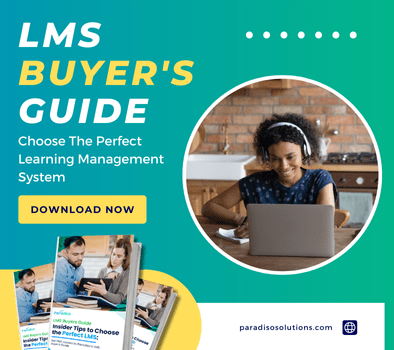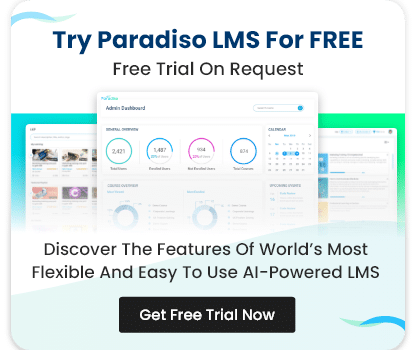More than 1000 LMS providers compete in today’s learning platforms industry. However, not all platforms are made equal. Therefore, before investing in an LMS, it’s critical to determine which technology is most suited to your needs. An external training LMS is a framework for delivering and managing instructional content; it must assess individual and organizational training goals, measure progress toward fulfilling those goals and gather data for controlling the organization’s overall learning process.
The user experience is the most successful component of a customer, partner, or member training learning management system in organizations and associations, both the front end for learners and the back end for whoever is administering the activities. eLearning (particularly self-paced eLearning) must engage learners via planning, monitoring, and, most significantly manner.
This blog will go over the essential components of an external learning management system, how to choose one, and why they’re necessary for a well-designed Customer training Learning Management System. You’ll learn about relevant integrations, content discovery, eCommerce functionality, and other topics.
What is external training LMS?
External learning management system LMS is designed for customers and business partners.
External courses are typically taught by experts who are knowledgeable not just in the subject matter of the training but also in teaching and have likely developed effective ways to guarantee that the movement is well received. In addition, a training team within the company frequently oversees it. External training types and usual aims are as follows:
- Enhance product and customer onboarding, as well as time-to-value.
- Boost product engagement and retention
- Increase the size of the Customer Success team.
If we talk about external training LMS, there are three types of LMS solutions:
Customer training LMS:
It is software for educating customers on how to efficiently and effectively use your product or service to attain their specific goals. However, these initiatives go beyond crucial selling points and USPs.
Your external training plan should cover every aspect of the customer experience. For example, customer training learning management system highlights add-ons or upgrades to maximize functionality and improve ROI. Guiding customers boosts brand engagement and adds more perceived value to your product.
Partner training LMS:
A re-seller training or channel partner training is an unavoidable prerequisite for expanding your business. It is critical to provide a channel partner training so that they may better understand the product’s features and advantages.
A mobile-friendly customer training learning management system allows partners greater freedom regarding when and where they may access their training. For example, if a salesperson has to review product specifications before meeting with a potential customer, they may instantly access a training video on their mobile device.
Associate member training:
The Association Learning Management System (ALMS) is a platform for engaging members, adding value to them, and building a fantastic learning and knowledge-sharing community. Furthermore, it is a platform for managing and streamlining all functions associated with the association’s learning and training program. Learning Management System benefits for External Training have recently gained considerable importance in every business for simplifying and providing flexibility to external and internal training programmed via eLearning.
Key points to remember before Choosing an External Training LMS
Extended enterprise features
You may need multiple portal support to train different audience groups, or external training LMS facilitated with e-commerce to process course sales. Integrating marketing automation systems and existing training software is another significant aspect, as it is a certification engine to encourage users and push course completion.
Proper integration
To reach a broader audience and efficiently boost contact between learners and instructors, social networks should be properly integrated so that they may share courses, post directly about the course they just completed, or even seek for help with a topic they are stuck on. This may be done on the course forum or on another social media site, which will ultimately lead to more people being aware of the course and, as a result, your course will eventually reach an even larger audience than before.
Focus on user experience
Because each learning experience is unique, worldwide video streaming, self-registration, and mobile responsiveness are all high objectives. Additionally, users should have a consistent appearance and experience when accessing your LMS for external education.
Real-time management
One key to establishing effective learner engagement tactics is to involve your learners as early as the data collection phase of the training cycle. While it is common practice to examine performance data to identify learning requirements and skill gaps, KPIs may not always complete the entire job.
Of course, numbers and statistics should be used for analysis, but they do not reveal the whole picture. Engagement is the most effective method for determining your learners’ actual learning demands.
What features should an External training LMS have?
The most challenging aspect of selecting the most acceptable Learning Management System benefits for External LMS Training is that each business has distinct demands and expectations. While one organization may focus on blended learning, another may go for VILT. However, there are a few critical aspects that no external Learning Management System should be without.
Comprehensive Tracking
Actionable data is required for practical training and development. How can you identify a skill shortfall and respond before the gaps get too large? Learning analytics may assist you in mapping workers’ abilities and identifying L&D shortcomings.
Personalized Learner Home Page
How can you design individualized training programs for your staff when they are dispersed throughout the globe and have varying L&D requirements? To provide a personalized experience, a personal learning home page incorporates drag-and-drop widgets, course recommendations, and accomplished milestones.
Offline education
Regardless of topic or scope, modern learners anticipate instruction that travels with them. To boost accessibility and allow on-the-go skill development, you’ll need a customer training learning management system supporting offline learning. They may participate in activities from any location by downloading the native app.
Dashboard of Integrated Skills
Your new skill development training platform should also offer an integrated skills dashboard to provide workforce leaders with a comprehensive picture of team performance.
AI-Enabled Social Learning
Many of us have been reminded of how sociable we are due to the COVID situation. This takes us to the list’s last component, AI-powered social learning. This feature enables you to establish topic-based message boards to encourage remote debate and cooperation.
Easy user interface
An LMS’s user interface design is what creates a user’s initial impression of a platform. The user experience determines whether or not the user returns to the LMS. A strong UI/UX design meets the commercial goals of the LMS owner while also providing the end-user with a high-quality learning tool. There are two sorts of users in learning management systems: learners and instructors. Each user type requires a unique interface and set of features in order for the instructional process to be effective. A robust LMS is well-suited to provide learners and instructors with appropriate capabilities.
Bottom Line
If you are looking for a fully-featured LMS for external education for your organization, Paradiso provides you with the best external learning management system. Continuous learning in the workplace is essential for talent development and skill development. The ideal LMS provides actionable insights to implement change inside your business and promote lifelong learning. A cost-effective external learning management system like Paradiso can help meet your goals in a budget-friendly manner. With Paradiso LMS, you can have an inbuilt authoring tool and the best integrations to achieve your service goals.

















